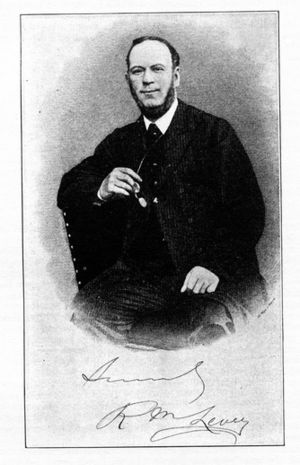Richard Michael Levey facts for kids
Quick facts for kids
R. M. Levey
|
|
|---|---|
 |
|
| Born | 25 October 1811 County Meath, Ireland
|
| Died | 28 June 1899 (aged 87) Dalkey, County Dublin
|
| Resting place | Glasnevin Cemetery |
| Occupation |
|
Richard Michael Levey (born October 25, 1811 – died June 28, 1899), also known as R. M. Levey, was a talented Irish musician. He was a violinist, conductor, composer, and teacher. Levey was important for keeping music alive in Dublin during tough economic times in the 1800s.
Contents
Richard Levey's Early Life and Career
Levey was born in County Meath, Ireland. His exact birthplace is not known. His first family name was O'Shaughnessy. However, he changed it to Levey, which was his mother's maiden name. He thought it sounded more musical. All of his children and future family members used the name Levey. Levey had a very large family.
He started learning the violin in Dublin. His teacher was James Barton. In 1826, when Levey was 15, he joined the orchestra at the Theatre Royal, Dublin. He later became the main leader of the orchestra there in 1834.
Leading the Theatre Royal Orchestra
From 1834 until 1880, Levey was the music director for the Theatre Royal. This was a very important job. He conducted the orchestra for plays and operas. He also wrote over 100 overtures, which are pieces of music played at the start of a show. He directed opera performances too. These included singers, a choir, and the orchestra.
Levey was also the leader of other orchestras in Dublin. These included the Antient Concerts Society and the Philharmonic Society. He was also a secretary for the Dublin Madrigal Society. People said he was "everywhere" at concerts in Dublin for over 50 years. He worked with both local and visiting musicians.
In 1829, Levey played in the orchestra for famous singer Angelica Catalani. He also played when Michael William Balfe's opera company visited Dublin in 1839. Levey even conducted the first Irish performance of Balfe's opera, The Maid of Artois, in 1840. Balfe and Levey were good friends for life.
Teaching and Irish Music
Levey was also a very important violin teacher in Dublin. In 1848, he helped start the Royal Irish Academy of Music. He taught violin there from the very beginning until 1897. In 1852, he started a special class for advanced students. This class was like the famous music schools in Paris and Leipzig. Two of his most famous students were Robert Prescott Stewart and Charles V. Stanford.
Levey was also very interested in traditional Irish music. He gave public talks about it. He also played the violin in talks given by others. In 1858, he published a book of over 100 Irish dance tunes. This collection is still used today.
Levey's Musical Family
Levey had many children. In 1837, he had triplets. Two of them became famous musicians. Richard Michael Levey junior (1837–1911) was a brilliant violin player. He was so good that people called him "Paganini Redivivus," meaning "Paganini reborn." Another son, William Charles Levey (1837–1894), became an opera composer and conductor.
Levey's great-grandson, Michael Levey (1927–2008), was also very famous. He was the director of the National Gallery in London. He also wrote a book about the famous composer Mozart.
Richard Levey lived a long life. He saw the new Theatre Royal open in 1897. He died in Dalkey, County Dublin, in 1899, at 87 years old. He is buried in Glasnevin Cemetery.
Levey's Impact on Dublin Music
Richard Levey was part of a special group of musicians in Dublin. Along with others like John William Glover and Robert Prescott Stewart, he helped keep music thriving. This was during a time when money was tight in Dublin.
People who knew Levey described him as a skilled musician and a good leader. They said he was a kind director and a respected person. Charles V. Stanford, one of his students, said Levey was a "great character." He was a strong player and an excellent leader of an orchestra.
Levey wrote many pieces of music. His published music for piano, voice, and groups was known for being skillful and light-hearted. Many of his pieces were quadrilles. These were popular dances based on fun topics of the day. They were often played by bands and also arranged for people to play at home on the piano.
Levey also wrote a book with John O'Rorke. It was called Annals of the Theatre Royal, Dublin. This book is an important source of information about Irish music and plays in the 1800s.
Selected Musical Works
Levey wrote many different types of music. Here are a few examples:
Piano Music
- Ali Baba, or The Forty Thieves Galop (1873)
- Arrah-na-Pogue, or The Wicklow Wedding Quadrille
- Robinson Crusoe Quadrilles (1870)
- The Banjo Quadrilles (1845) – based on popular American melodies.
Ensemble Music
- Carnival de Venise, for banjo and piano (1874)
- The Great Ka-foozle-um Galop, for cornet and piano (1866)
Vocal Music
- Erin's Daughter. A Beautiful Ballad
- Limerick is Beautiful (1866) – with words by Dion Boucicault.
Folk Music Collection
- A Collection of the Dance Music of Ireland (1858) – This book of Irish dance tunes is still used today.
Book
- Annals of the Theatre Royal, Dublin (1880) – A history of the Theatre Royal in Dublin.

